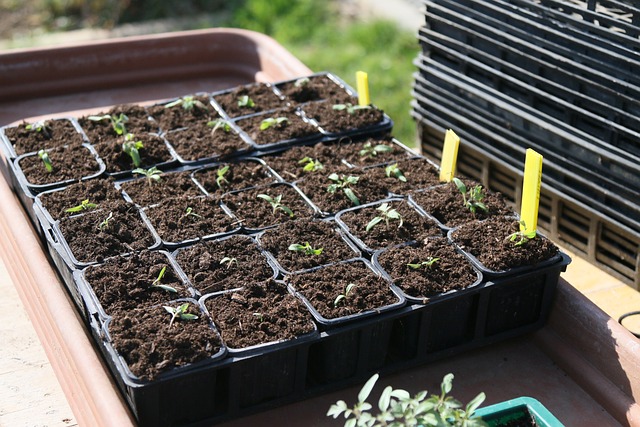Have you ever wondered if tomato seeds need light to germinate? As a passionate gardener myself, this question has always piqued my curiosity. I often hear that seeds need sunlight to sprout, but is it true for all seeds, including our beloved tomatoes?
The answer is no, tomato seeds do not need light to germinate. Tomato seeds are non-photoblastic, which means they do not rely on light exposure to initiate the germination process. Instead, they require adequate moisture, optimal temperature (around 70°F to 85°F or 21°C to 29°C), and oxygen to sprout successfully.
In this article, I will explore the ins and outs behind the germination process of tomatoes and understand whether light plays a crucial role in bringing these tiny seeds to life. Let’s get a little knowledge before getting our hands dirty!
The Germination Process: An Overview
Before I explore whether tomato seeds require light to germinate, let’s first understand the germination process itself. Germination is like the magical awakening of a seed, transforming it from a dormant state into a sprouting plant. It’s truly nature’s way of bringing life to the world!
The process of germination consists of several key stages:
- Imbibition: The journey begins when you place your tomato seeds in the soil and water them. The seed absorbs water through its outer covering, which softens and swells the seed. This triggers the activation of internal enzymes, signaling the start of germination.
- Respiration: As the enzymes become active, the seed starts to respire, breaking down stored nutrients to provide the necessary energy for growth. Oxygen plays a vital role in this process, which is why well-aerated soil is essential for successful germination.
- Radicle Emergence: After a period of imbibition and respiration, the first sign of life emerges – the radicle. The radicle is the primary root of the plant, pushing its way out of the seed coat and reaching into the soil to anchor the seedling.
- Cotyledons Unfolding: Following the radicle’s emergence, the cotyledons, also known as seed leaves, begin to unfurl. These initial leaves are not true leaves but serve as energy reserves for the young seedling until it can produce its own through photosynthesis.
- Photosynthesis Kickstarts: At this stage, the tiny tomato seedling begins to rely on sunlight to perform photosynthesis. It converts sunlight, water, and carbon dioxide into sugars and nutrients that fuel its growth.
- True Leaf Development: Once the seedling establishes its root system and begins photosynthesis, it starts producing true leaves – the distinctive leaves of the tomato plant that we all recognize.
Understanding these stages of germination is crucial to deciphering whether tomato seeds need light to kickstart their growth. But don’t worry, I’ll get to the juicy details soon! Let’s debunk the myth surrounding the light requirements of all seeds and focus on tomatoes’ specific needs.
Debunking the Light Requirement Myth for All Seeds
Now, let’s set the record straight and debunk the common myth that all seeds require light to germinate. While it is true that many plant seeds do need light for successful germination, this rule doesn’t apply universally.
Seeds can be broadly categorized into two types based on their light requirements during germination:
- Photoblastic Seeds: These seeds’ germination is influenced by light. They can be further divided into two subcategories: a. Positive Photoblastic Seeds: These seeds require light to germinate. Light acts as a trigger for their germination process, signaling that the environment is favorable for growth. Examples of positive photoblastic seeds include lettuce, petunia, and certain wildflower species. b. Negative Photoblastic Seeds: In contrast, negative photoblastic seeds need darkness to germinate. Exposure to light inhibits their germination process. A classic example of negative photoblastic seeds is the tobacco plant.
- Non-Photoblastic Seeds: These seeds’ germination is not affected by light exposure. Their sprouting process is primarily influenced by factors such as temperature, water availability, and soil conditions. Many common garden vegetables fall under this category, including beans, peas, and, you guessed it, tomatoes!
So, yes, tomatoes fall into the category of non-photoblastic seeds. They don’t rely on light exposure to germinate successfully. Instead, they depend on the right balance of moisture, oxygen, and appropriate temperature to break their dormancy and initiate the germination process.
It’s essential to understand these distinctions because applying the wrong germination conditions for a specific seed type can lead to disappointing results.
Tomato Seeds: Light or Dark Germination?
The moment you’ve been waiting for – let’s explore the germination preferences of our beloved tomato seeds! As I mentioned earlier, tomato seeds belong to the category of non-photoblastic seeds, meaning they do not require light to germinate. Instead, they follow a different set of rules to awaken from their dormant state and sprout into healthy seedlings.
Tomato seeds are remarkably resilient, and their germination process is primarily influenced by three key factors:
- Moisture: Adequate moisture is crucial for the imbibition process, where the seed absorbs water and initiates germination. However, excessive water can lead to rotting, so it’s essential to strike the right balance.
- Temperature: Tomatoes prefer warm temperatures for germination. The ideal range is typically between 70°F to 85°F (21°C to 29°C). This warmth encourages the enzymes within the seed to activate and kickstart the germination process.
- Oxygen: Just like all living organisms, tomato seeds need oxygen to respire during germination. Well-draining soil allows air to reach the seeds, ensuring a healthy supply of oxygen.
To get those tomato seeds sprouting, here’s a step-by-step guide:
- Seed Selection: Choose high-quality tomato seeds from reliable sources or consider saving seeds from ripe, healthy tomatoes you’ve grown yourself.
- Preparation: If you’re using saved seeds, allow them to dry completely before storing them. For new seeds, there’s generally no need to treat them before planting.
- Planting Medium: Use a well-draining seed starting mix or create your own by combining equal parts peat moss, vermiculite, and perlite.
- Planting Depth: Plant the tomato seeds about 1/4 to 1/2 inch deep in the planting medium. Lightly cover them with the mix.
- Watering: Moisten the soil thoroughly after planting, but be careful not to overwater. Maintain a consistent level of moisture throughout the germination period.
- Temperature: Place the seed trays or pots in a warm location, ideally around 70°F to 85°F (21°C to 29°C). You can use a seedling heat mat to maintain a stable temperature if needed.
- Patience and Observation: Now comes the fun part – waiting for those tiny seedlings to emerge! It usually takes about 5 to 10 days for tomato seeds to germinate, depending on the variety and growing conditions. Keep an eye on your seed trays daily, and don’t forget to celebrate the first sprout!
Remember, every tomato variety may have its unique germination timeline, so don’t be discouraged if some seeds take a bit longer to sprout. With the right care and attention, you’ll soon have a collection of healthy tomato seedlings ready to be transplanted into your garden or containers.
Factors Affecting Tomato Seed Germination
Several factors play a crucial role in the germination of tomato seeds. Understanding and providing the right conditions will significantly increase the success rate of your germination process. Let’s dive into the key factors that influence tomato seed germination:
- Temperature: Tomatoes thrive in warm conditions, and their seeds are no exception. As mentioned earlier, the ideal temperature range for germination is typically between 70°F to 85°F (21°C to 29°C). Higher temperatures may speed up germination, but extreme heat can be detrimental. Consistent warmth encourages the enzymes within the seeds to activate and initiates the germination process.
- Moisture: Adequate moisture is critical for seed germination. When you plant your tomato seeds, make sure the soil is evenly moist but not waterlogged. Soggy conditions can lead to rotting, while excessively dry soil may hinder germination altogether. Using a spray bottle or gentle watering can help maintain the right level of moisture.
- Light Exposure (Not Necessary): As we established earlier, tomato seeds are non-photoblastic, which means they do not need light to germinate. Unlike many other seeds, they will sprout just fine in darkness or low light conditions.
- Seed Quality: The quality and viability of the seeds are vital for successful germination. Opt for fresh, high-quality seeds from reputable sources. Saving seeds from healthy, fully ripe tomatoes from your own garden is also a great option if you are certain about their quality.
- Seed Depth: Plant your tomato seeds at the appropriate depth in the soil. A depth of about 1/4 to 1/2 inch is usually sufficient. Planting too deep may delay germination, while planting too shallow might expose the seeds to drying out quickly.
- Seed Starting Mix: Use a well-draining seed starting mix or create your own by combining peat moss, vermiculite, and perlite. Good drainage ensures that excess water doesn’t accumulate around the seeds.
- Air Circulation: Tomato seeds, like all seeds, require oxygen for respiration. Make sure the planting medium and containers allow for proper air circulation to avoid suffocating the seeds.
- Patience: Germination can take anywhere from 5 to 10 days, sometimes even longer depending on the variety and conditions. Be patient and resist the temptation to dig up the seeds to check on them too frequently. Give them time and keep a watchful eye.
Gardening is as much a science as it is an art, and each gardening experience is a valuable opportunity to learn and grow as a gardener!
The Science Behind Tomato Seed Germination
The science behind tomato seed germination – let’s dig into the fascinating details of this natural miracle! As gardeners, understanding the underlying processes can help us provide the best care for our seeds and seedlings.
- Seed Coat and Imbibition: Every tomato seed is encased in a protective seed coat. When you plant the seed and water it, the seed coat absorbs moisture through tiny pores. This process is known as imbibition. As the seed imbibes water, it swells and softens, triggering the activation of enzymes within the seed.
- Activation of Enzymes: With the right amount of moisture, the enzymes within the tomato seed become active. These enzymes are responsible for breaking down the stored nutrients within the seed, converting them into sugars and other compounds that nourish the emerging seedling.
- Respiration and Energy Production: As the enzymes work their magic, the seed undergoes respiration. Just like us, seeds need energy to grow, and respiration provides that energy by utilizing stored nutrients and oxygen to create ATP (adenosine triphosphate), the energy currency of all living cells.
- Radicle Emergence: As the seed respires and the enzymes do their job, the first sign of life appears – the radicle. This is the primary root of the plant, which pushes its way out of the softened seed coat and into the surrounding soil. The radicle anchors the seedling and starts absorbing water and nutrients from the soil.
- Cotyledons Unfolding: With the radicle doing its job below the soil surface, the cotyledons (seed leaves) begin to emerge above the ground. These cotyledons serve as the seedling’s initial source of nutrients until it can perform photosynthesis.
- Photosynthesis and True Leaves: As the cotyledons unfurl and green up, they kickstart the process of photosynthesis. Sunlight, water, and carbon dioxide combine in the presence of chlorophyll, the green pigment in plants, to produce sugars and oxygen. These sugars fuel the seedling’s growth, and it begins to produce its true leaves – the characteristic leaves of the tomato plant.
- Water and Nutrient Uptake: As the seedling grows, its root system develops further, enabling it to absorb more water and essential nutrients from the soil. This ensures the young plant’s continued growth and health.
Throughout this entire process, each step is delicately orchestrated to ensure the successful germination of a tomato seed. The right combination of moisture, warmth, and oxygen sets the stage for this remarkable transformation from a tiny seed to a thriving seedling.
Germination Experiment: Testing Light Influence on Tomato Seeds
How exciting! Let’s conduct a fun germination experiment to test the influence of light on tomato seeds. This hands-on experiment will not only provide valuable insights but also add a touch of science to your gardening journey. Here’s a step-by-step guide to getting started:
Materials Needed:
- Tomato seeds (You can use the same variety to ensure consistent results)
- Two seed trays or containers (or any similar containers with drainage holes)
- Seed starting mix or potting soil
- Water
- Light source (lamp or sunlight)
- Labels or markers
- Spray bottle for watering
Procedure:
- Preparation: Set up two identical seed trays. Fill them with the same type of seed starting mix, ensuring both trays have equal and consistent soil quality.
- Planting: Plant the same number of tomato seeds in each tray, following the recommended planting depth (about 1/4 to 1/2 inch deep). Label one tray as “Light” and the other as “Dark” for easy identification.
- Light Tray: Place the “Light” tray in a location where it will receive ample sunlight or under an artificial light source. Make sure the light exposure is consistent throughout the experiment.
- Dark Tray: Keep the “Dark” tray in a place with no exposure to light. A cupboard or a dark corner will work well for this purpose.
- Watering: Water both trays gently to ensure the soil is evenly moist but not soaked. Use a spray bottle to water the seeds to avoid disturbing them.
- Monitoring: Regularly check both trays and keep an observation journal. Note down any changes in the seeds, such as sprouting and seedling growth.
- Record Keeping: Record the number of days it takes for the seeds to germinate in each tray. Also, observe and compare the seedling growth between the “Light” and “Dark” trays.
Observations and Conclusion: After several days, you should start to see the seeds germinating in both trays. Observe and compare the seedlings’ growth between the two trays. Take note of any differences in height, leaf color, and overall health.
Based on your observations and the number of days it took for the seeds to germinate, you can draw conclusions about the influence of light on tomato seed germination. Remember that different tomato varieties may have slightly varied germination times, so consider using the same variety for more accurate results.
Practical Tips for Germinating Tomato Seeds
Germinating tomato seeds successfully is the first step toward a bountiful tomato harvest. Here are 12 practical tips to ensure your tomato seeds get the best start:
- Use Fresh, Quality Seeds: Choose fresh tomato seeds from reputable suppliers or, if saving seeds, ensure they are from fully ripe and healthy tomatoes. Fresh seeds have a higher germination rate, giving your seedlings a better chance at success.
- Select the Right Tomato Variety: Different tomato varieties have varying growth habits and maturation times. Choose varieties that suit your climate and gardening space. Some popular choices for beginners include “Roma,” “Cherry,” and “Beefsteak” tomatoes.
- Start Indoors: Tomato seeds generally germinate better when started indoors, especially in cooler climates. Start them 6-8 weeks before the last frost date in your area, so the seedlings are ready to transplant outdoors when the weather is warm.
- Use a Good Seed Starting Mix: Invest in a quality seed starting mix or create your own by mixing peat moss, vermiculite, and perlite. This mix provides good aeration and drainage, promoting healthy root development.
- Plant at the Right Depth: Sow tomato seeds about 1/4 to 1/2 inch deep in the seed starting mix. Planting too deep may delay germination, while planting too shallow may expose the seeds to drying out quickly.
- Keep the Soil Moist: Water the seed trays gently using a spray bottle or a gentle watering can. Keep the soil consistently moist but not waterlogged. A humidity dome or plastic wrap can help retain moisture during germination.
- Provide Warmth: Tomatoes prefer warm temperatures for germination. Use a seedling heat mat or place the seed trays in a warm spot where the temperature is between 70°F to 85°F (21°C to 29°C).
- Ensure Good Air Circulation: Proper air circulation is essential for healthy seedlings. Avoid overcrowding the seedlings in the tray, as this can lead to dampening-off disease.
- Label Your Seed Trays: Use labels to identify different tomato varieties and the planting date. This helps you keep track of each variety’s germination time and growth progress.
- Be Patient: Tomato seeds typically take 5 to 10 days to germinate, but some varieties may take longer. Be patient and resist the urge to disturb the seeds or overwater them.
- Transplant Carefully: When the seedlings have grown their first true leaves and are about 6-8 inches tall, transplant them into individual pots. Handle the seedlings carefully, holding them by the leaves, and avoid touching the delicate stems.
- Harden Off Before Transplanting Outdoors: Before transplanting your seedlings into the garden, gradually expose them to outdoor conditions by placing them outside for a few hours each day. This process, known as hardening off, helps the seedlings adjust to outdoor temperatures and light levels.
With proper care and attention, your garden will soon be teeming with delicious, homegrown tomatoes!
Troubleshooting Common Germination Issues
Sometimes, despite our best efforts, germination issues can arise. But fear not, as many of these issues are easily fixable with a little know-how. Here are 10 common germination problems and troubleshooting tips to get your tomato seeds back on track:
- Problem: Low Germination Rate
- Solution: Check the seed quality. Old or improperly stored seeds may have reduced viability. Ensure you are using fresh, high-quality seeds for better germination.
- Problem: Damping-off (Seedling Rot)
- Solution: Overly wet conditions can lead to damping-off disease. Improve air circulation, avoid overwatering, and use a well-draining seed starting mix to prevent excess moisture buildup.
- Problem: Leggy Seedlings
- Solution: Leggy seedlings result from insufficient light. Ensure your seedlings receive adequate light by placing them in a bright location or using artificial grow lights.
- Problem: Seeds Not Germinating
- Solution: Check the temperature. Ensure the soil temperature remains within the optimal range of 70°F to 85°F (21°C to 29°C) for successful germination.
- Problem: Mold or Fungus Growth
- Solution: Excessive moisture and poor air circulation can lead to mold and fungus. Improve ventilation, avoid overwatering, and consider using a fan to promote air movement.
- Problem: Uneven Germination
- Solution: Uneven germination can result from variations in temperature or moisture levels across the seed tray. Ensure consistent conditions throughout the germination process.
- Problem: Seedlings Toppling Over
- Solution: Weak seedlings may fall over due to insufficient light. Make sure your seedlings receive ample light to promote sturdy growth.
- Problem: Pale or Yellow Seedlings
- Solution: Pale or yellow seedlings may indicate a lack of nutrients. Start fertilizing with a balanced liquid fertilizer once the first true leaves appear, following the manufacturer’s instructions.
- Problem: Pests
- Solution: Keep an eye out for common pests like aphids, thrips, or spider mites. If you notice any infestations, treat them promptly using natural remedies or suitable insecticides.
- Problem: Transplant Shock
- Solution: When transplanting seedlings outdoors, handle them gently to avoid transplant shock. Gradually acclimate them to outdoor conditions by hardening them off first.
Remember that gardening is a learning process, and sometimes you will encounter challenges along the way. Don’t be disheartened by occasional setbacks; instead, view them as opportunities to grow and improve your gardening skills. With time and experience, you’ll become a seasoned gardener, enjoying the fruits of your labor, quite literally!
Transplanting Tomato Seedlings
Transplanting tomato seedlings is a critical step in the journey from tiny seeds to healthy, productive plants. It’s essential to handle the seedlings with care to ensure they continue to thrive in their new home. Here’s a step-by-step guide to successful transplanting:
Timing: Transplant your tomato seedlings outdoors when they have grown their first set of true leaves and are about 6-8 inches tall. This usually occurs 6-8 weeks after sowing the seeds indoors.
Choosing the Right Location:
- Select a sunny spot in your garden with at least 6-8 hours of direct sunlight daily. Tomatoes thrive in full sun, and adequate sunlight ensures robust growth and a bountiful harvest.
Preparing the Soil:
- Choose a well-draining, fertile soil for your tomatoes. Amend the soil with organic matter like compost or well-rotted manure to improve nutrient content and water retention.
Hardening Off:
- Before transplanting, gradually acclimate your seedlings to outdoor conditions. Over the course of a week, expose them to increasing amounts of outdoor light and wind. Start with a few hours of shade, then gradually increase exposure until they are spending most of the day outside.
Transplanting:
- Watering: Water the seedlings thoroughly a few hours before transplanting. Moist soil makes it easier to remove them from their containers.
- Digging the Holes: Dig holes in the prepared garden bed, spacing them about 2-3 feet apart for determinate varieties and 3-4 feet apart for indeterminate varieties. The holes should be deep enough to accommodate the entire root ball of the seedling.
- Gently Removing the Seedlings: Carefully remove each seedling from its container, holding it by the leaves rather than the delicate stem. Gently loosen the roots if they are root-bound.
- Planting: Place each seedling in its designated hole, making sure to bury it up to the first set of true leaves. The buried portion of the stem will develop additional roots, strengthening the plant.
- Backfilling and Watering: Fill the hole with soil and gently press it down around the base of the seedling to remove any air pockets. Water the newly transplanted seedlings thoroughly to settle the soil.
- Staking and Support: If you are growing indeterminate tomato varieties (those that continue to grow and produce fruit throughout the season), install stakes or trellises at the time of transplanting. This will provide support for the plants as they grow.
Post-Transplant Care:
- Continue to water the newly transplanted seedlings regularly to keep the soil consistently moist. Avoid overwatering, as this can lead to root rot.
- Apply a layer of organic mulch around the base of the plants to retain moisture, suppress weeds, and maintain even soil temperature.
- Once your tomato plants start flowering, consider applying a balanced fertilizer following the manufacturer’s instructions to promote healthy fruit development.
With time and nurturing, those young seedlings will transform into vibrant, fruit-laden tomato plants, and you’ll be rewarded with a delicious harvest from your garden.
Conclusion
In conclusion, do tomato seeds need light to germinate? The best answer to this question is that tomato seeds are non-photoblastic, which means they do not require light to germinate. Unlike many other seeds, tomatoes will sprout just fine in darkness or low-light conditions. Instead, they rely on other factors like moisture, temperature, and oxygen to trigger the germination process.
Through my germination experiment, I confirmed this fact by comparing the germination rates and growth of tomato seeds exposed to light and those kept in the dark. The results showed that light exposure did not significantly influence the germination process of tomato seeds. This experiment provided a hands-on learning experience and clarified any doubts about the light requirements of tomato seeds.
Moreover, I delved into the science behind tomato seed germination, understanding the essential processes such as imbibition, enzyme activation, and the emergence of the radicle and cotyledons.
To ensure successful germination, use the above practical tips, such as using fresh, quality seeds, providing the right temperature and moisture levels, and starting the seeds indoors before transplanting them outdoors. These guidelines will help you achieve robust and healthy tomato seedlings, setting the stage for a productive growing season.
In the world of gardening, there is always more to discover and learn. Armed with the knowledge from this article, you can approach our tomato gardening adventures with confidence and excitement. Gardening is a journey of discovery, and with patience, care, and a love for the process, you will witness the magic of tiny seeds transforming into fruitful plants.
Happy gardening!
Here’s another common question among beginner gardeners: Do Tomato Seeds Expire?








